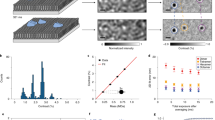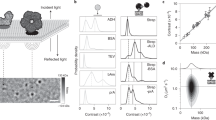Abstract
This protocol describes an in vitro approach for measuring the kinetics and affinities of interactions between membrane-anchored proteins. This method is particularly established for dissecting the interaction dynamics of cytokines with their receptor subunits. For this purpose, the receptor subunits are tethered in an orientated manner onto solid-supported lipid bilayers by using multivalent chelator lipids. Interaction between the ligand with the receptor subunits was probed by a combination of surface-sensitive spectroscopic detection techniques. Label-free detection by reflectance interferometry is used for following assembly of the membrane and tethering of the receptor subunits in quantitative terms. Total internal reflection spectroscopy is used for monitoring ligand binding to the membrane-anchored receptor, for monitoring ligand-receptor interactions by FRET and for monitoring ligand-exchange kinetics. These assays can be used for determining the affinities and stabilities of ligand-receptor complexes in plane of the membrane. The techniques described in this protocol can be established in 2–3 months.
This is a preview of subscription content, access via your institution
Access options
Subscribe to this journal
Receive 12 print issues and online access
$259.00 per year
only $21.58 per issue
Buy this article
- Purchase on Springer Link
- Instant access to full article PDF
Prices may be subject to local taxes which are calculated during checkout








Similar content being viewed by others
References
Cooper, M.A. Label-free screening of bio-molecular interactions. Anal. Bioanal. Chem. 377, 834–842 (2003).
Homola, J. Present and future of surface plasmon resonance biosensors. Anal. Bioanal. Chem. 377, 528–539 (2003).
Liedberg, B., Nylander, C. & Lundstrom, I. Surface-plasmon resonance for gas-detection and biosensing. Sens. Actuators 4, 299–304 (1983).
Edwards, P.R. et al. Kinetics of protein–protein interactions at the surface of an optical biosensor. Anal. Biochem. 231, 210–217 (1995).
Schmitt, H.M., Brecht, A., Piehler, J. & Gauglitz, G. An integrated system for optical biomolecular interaction analysis. Biosensors & Bioelectronics 12, 809–816 (1997).
Salamon, Z., Macleod, H.A. & Tollin, G. Coupled plasmon-waveguide resonators: a new spectroscopic tool for probing proteolipid film structure and properties. Biophys. J. 73, 2791–2797 (1997).
Marx, K.A. Quartz crystal microbalance: a useful tool for studying thin polymer films and complex biomolecular systems at the solution-surface interface. Biomacromolecules 4, 1099–1120 (2003).
Hook, F. et al. Variations in coupled water, viscoelastic properties, and film thickness of a Mefp-1 protein film during adsorption and cross-linking: a quartz crystal microbalance with dissipation monitoring, ellipsometry, and surface plasmon resonance study. Anal. Chem. 73, 5796–5804 (2001).
Reimhult, E., Larsson, C., Kasemo, B. & Hook, F. Simultaneous surface plasmon resonance and quartz crystal microbalance with dissipation monitoring measurements of biomolecular adsorption events involving structural transformations and variations in coupled water. Anal. Chem 76, 7211–7220 (2004).
Lata, S., Reichel, A., Brock, R., Tampé, R. & Piehler, J. High-affinity adaptors for switchable recognition of histidine-tagged proteins. J. Am. Chem. Soc. 127, 10205–10215 (2005).
Gavutis, M., Lata, S., Lamken, P., Müller, P. & Piehler, J. Lateral ligand-receptor interactions on membranes probed by simultaneous fluorescence-interference detection. Biophys. J. 88, 4289–4302 (2005).
Liebermann, T. & Knoll, W. Surface-plasmon field-enhanced fluorescence spectroscopy. Colloids and Surfaces a-Physicochemical and Engineering Aspects 171, 115–130 (2000).
Neumann, T., Johansson, M.L., Kambhampati, D. & Knoll, W. Surface-plasmon fluorescence spectroscopy. Advanced Functional Materials 12, 575–586 (2002).
Piehler, J. & Schreiber, G. Fast transient cytokine-receptor interactions monitored in real time by reflectometric interference spectroscopy. Analytical Biochemistry 289, 173–186 (2001).
Glaser, R.W. Antigen-antibody binding and mass transport by convection and diffusion to a surface: a two-dimensional computer model of binding and dissociation kinetics. Anal. Biochem. 213, 152–61 (1993).
Goldstein, B., Coombs, D., He, X., Pineda, A.R. & Wofsy, C. The influence of transport on the kinetics of binding to surface receptors: application to cells and BIAcore. J. Mol. Recognit. 12, 293–299 (1999).
Schuck, P. & Minton, A.P. Analysis of mass transport-limited binding kinetics in evanescent wave biosensors. Anal. Biochem. 240, 262–272 (1996).
Lata, S., Gavutis, M. & Piehler, J. Monitoring the dynamics of ligand-receptor complexes on model membranes. J. Am. Chem. Soc. 128, 6–7 (2006).
Gavutis, M., Jaks, E., Lamken, P. & Piehler, J. Determination of the 2-dimensional interaction rate constants of a cytokine receptor complex. Biophys. J. 90, 3345–3355 (2006).
Lamken, P. et al. Functional cartography of the extracellular domain of the type I interferon receptor subunit ifnar1. J. Mol. Biol. 350, 476–88 (2005).
Lamken, P., Lata, S., Gavutis, M. & Piehler, J. Ligand-induced assembling of the type I interferon receptor on supported lipid bilayers. J. Mol. Biol. 341, 303–318 (2004).
Lata, S. & Piehler, J. A multivalent chelator lipid for stably tethering histidine-tagged proteins onto membranes. Nature Protocols (2006)(doi:10.1038/nprot.2006.271).
Eddowes, M.J. Direct immunochemical sensing: basic chemical principles and fundamental limitations. Biosensors 3, 1–15 (1987).
Karlsson, R., Michaelsson, A. & Mattsson, L. Kinetic analysis of monoclonal antibody-antigen interactions with a new biosensor based analytical system. J. Immunol. Methods 145, 229–240 (1991).
Author information
Authors and Affiliations
Corresponding author
Ethics declarations
Competing interests
The authors declare no competing financial interests.
Rights and permissions
About this article
Cite this article
Gavutis, M., Lata, S. & Piehler, J. Probing 2-dimensional protein–protein interactions on model membranes. Nat Protoc 1, 2091–2103 (2006). https://doi.org/10.1038/nprot.2006.270
Published:
Issue Date:
DOI: https://doi.org/10.1038/nprot.2006.270
This article is cited by
-
Kinetic study of membrane protein interactions: from three to two dimensions
Scientific Reports (2024)
-
Critical parameters for design and development of multivalent nanoconstructs: recent trends
Drug Delivery and Translational Research (2022)
-
Multi-functional DNA nanostructures that puncture and remodel lipid membranes into hybrid materials
Nature Communications (2018)
-
Ligand-induced type II interleukin-4 receptor dimers are sustained by rapid re-association within plasma membrane microcompartments
Nature Communications (2017)
-
High efficiency cell-specific targeting of cytokine activity
Nature Communications (2014)
Comments
By submitting a comment you agree to abide by our Terms and Community Guidelines. If you find something abusive or that does not comply with our terms or guidelines please flag it as inappropriate.



